五年级unit7 Do you want coffee or tea
- 格式:ppt
- 大小:952.50 KB
- 文档页数:23
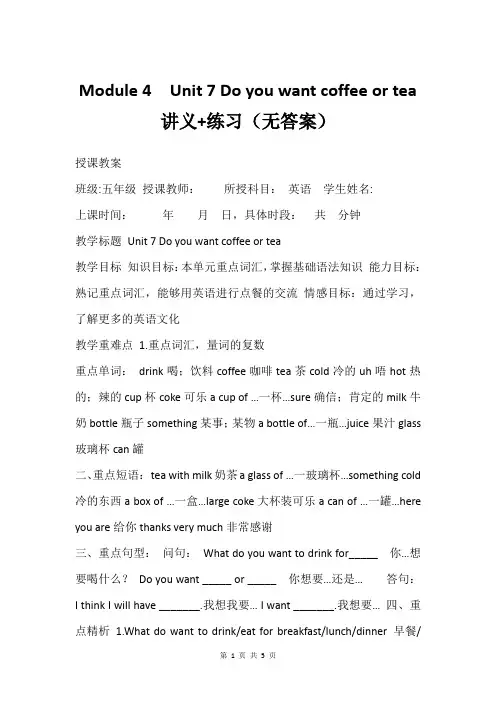
Module 4 Unit 7 Do you want coffee or tea讲义+练习(无答案)授课教案班级:五年级授课教师:所授科目:英语学生姓名:上课时间:年月日,具体时段:共分钟教学标题Unit 7 Do you want coffee or tea教学目标知识目标:本单元重点词汇,掌握基础语法知识能力目标:熟记重点词汇,能够用英语进行点餐的交流情感目标:通过学习,了解更多的英语文化教学重难点1.重点词汇,量词的复数重点单词:drink喝;饮料coffee咖啡tea茶cold冷的uh唔hot热的;辣的cup杯coke可乐a cup of …一杯…sure确信;肯定的milk牛奶bottle瓶子something某事;某物a bottle of…一瓶…juice果汁glass 玻璃杯can罐二、重点短语:tea with milk奶茶a glass of …一玻璃杯…something cold 冷的东西a box of …一盒…large coke大杯装可乐a can of …一罐…here you are给你thanks very much非常感谢三、重点句型:问句:What do you want to drink for_____ 你…想要喝什么?Do you want _____ or _____ 你想要…还是… 答句:I think I will have _______.我想我要… I want _______.我想要… 四、重点精析1.What do want to drink/eat for breakfast/lunch/dinner 早餐/午餐/晚餐你想喝/吃什么?回答可以用以下句型:I want…. I think I will have… Can I please have… ____________________________________ 你午餐想喝什么?____________________________________ 我要喝一杯咖啡。
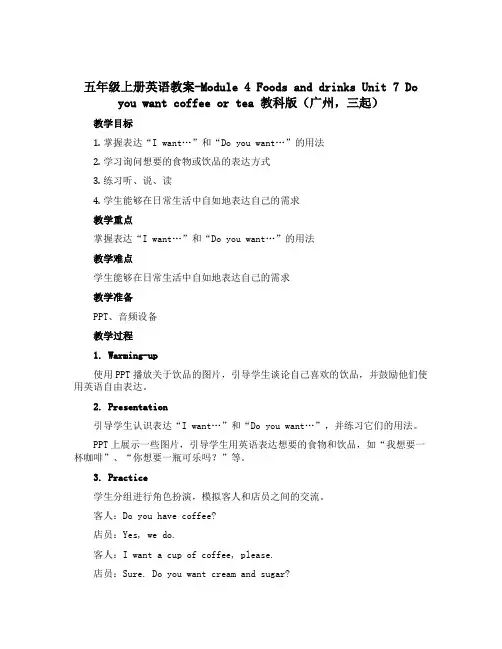
五年级上册英语教案-Module 4 Foods and drinks Unit 7 Do you want coffee or tea 教科版(广州,三起)教学目标1.掌握表达“I want…”和“Do you want…”的用法2.学习询问想要的食物或饮品的表达方式3.练习听、说、读4.学生能够在日常生活中自如地表达自己的需求教学重点掌握表达“I want…”和“Do you want…”的用法教学难点学生能够在日常生活中自如地表达自己的需求教学准备PPT、音频设备教学过程1. Warming-up使用PPT播放关于饮品的图片,引导学生谈论自己喜欢的饮品,并鼓励他们使用英语自由表达。
2. Presentation引导学生认识表达“I want…”和“Do you want…”,并练习它们的用法。
PPT上展示一些图片,引导学生用英语表达想要的食物和饮品,如“我想要一杯咖啡”、“你想要一瓶可乐吗?”等。
3. Practice学生分组进行角色扮演,模拟客人和店员之间的交流。
客人:Do you have coffee?店员:Yes, we do.客人:I want a cup of coffee, please.店员:Sure. Do you want cream and sugar?客人:Yes, please. One cream and two sugars.店员:OK. Here you are. Enjoy your coffee!4. Production学生在学习过程中通过活动、游戏等形式进行语言环境的营造,在与小组成员的交流中巩固所学内容,并逐渐形成良好的语言表达习惯。
5. Review播放音频或展示图片,学生跟读、表演,巩固所学内容。
6. Exercise完成练习册上的相关练习,检查学生对所学知识的掌握程度。
7. Assessment评估学生的学习成果,根据学生的表现进行综合性评价。
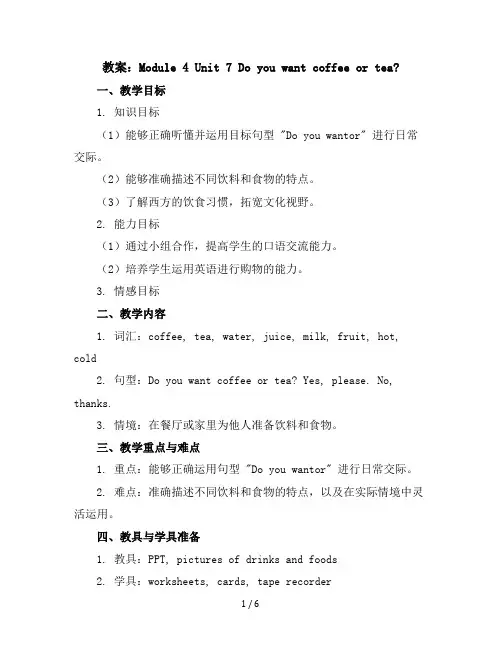
教案:Module 4 Unit 7 Do you want coffee or tea?一、教学目标1. 知识目标(1)能够正确听懂并运用目标句型 "Do you wantor" 进行日常交际。
(2)能够准确描述不同饮料和食物的特点。
(3)了解西方的饮食习惯,拓宽文化视野。
2. 能力目标(1)通过小组合作,提高学生的口语交流能力。
(2)培养学生运用英语进行购物的能力。
3. 情感目标二、教学内容1. 词汇:coffee, tea, water, juice, milk, fruit, hot, cold2. 句型:Do you want coffee or tea? Yes, please. No, thanks.3. 情境:在餐厅或家里为他人准备饮料和食物。
三、教学重点与难点1. 重点:能够正确运用句型 "Do you wantor" 进行日常交际。
2. 难点:准确描述不同饮料和食物的特点,以及在实际情境中灵活运用。
四、教具与学具准备1. 教具:PPT, pictures of drinks and foods2. 学具:worksheets, cards, tape recorder五、教学过程1. Preclass preparation(1) Review previous knowledge: introduce the words and phrases about drinks and foods.(2) Leadin: ask students questions about their favorite drinks and foods.2. Classroom presentation(1) Introduce the new words and phrases related to the lesson.(2) Present the dialogue: show pictures and use gestures to help students understand the meaning of the sentences.(3) Practice the dialogue: ask students to read the dialogue aloud and roleplay with their partners.3. Practice(1) Group work: students work in groups to create their own dialogues using the target sentence structure.(2) Oral practice: ask students to practice the dialogue with their classmates.4. Consolidation(1) Ask students to write a short passage about their favorite drinks and foods.(2) Roleplay: ask students to perform their dialogues in front of the class.六、板书设计1. The new words and phrases: coffee, tea, water, juice, milk, fruit, hot, cold2. The target sentence structure: Do you wantor? Yes, please. No, thanks.七、作业设计1. Write a short passage about their favorite drinks and foods.2. Practice the dialogue with their partners and record it.八、课后反思1. Reflect on the effectiveness of the teaching methods and activities used in the classroom.2. Consider the individual needs of students and adjust the teaching strategies accordingly.3. Evaluate the students' understanding and speaking ability, and provide further guidance if necessary.一、Preclass preparation1. 复习旧知识:教师可以通过提问的方式,让学生回顾已学的单词和短语,如饮料和食物的相关词汇。
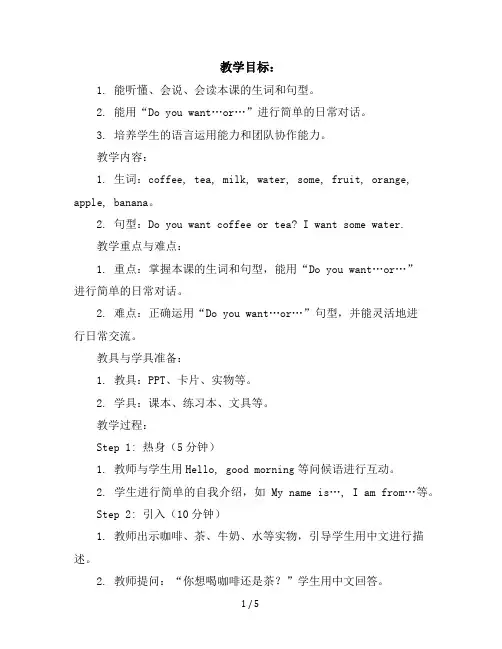
教学目标:1. 能听懂、会说、会读本课的生词和句型。
2. 能用“Do you want…or…”进行简单的日常对话。
3. 培养学生的语言运用能力和团队协作能力。
教学内容:1. 生词:coffee, tea, milk, water, some, fruit, orange, apple, banana。
2. 句型:Do you want coffee or tea? I want some water.教学重点与难点:1. 重点:掌握本课的生词和句型,能用“Do you want…or…”进行简单的日常对话。
2. 难点:正确运用“Do you want…or…”句型,并能灵活地进行日常交流。
教具与学具准备:1. 教具:PPT、卡片、实物等。
2. 学具:课本、练习本、文具等。
教学过程:Step 1: 热身(5分钟)1. 教师与学生用Hello, good morning等问候语进行互动。
2. 学生进行简单的自我介绍,如My name is…, I am from…等。
Step 2: 引入(10分钟)1. 教师出示咖啡、茶、牛奶、水等实物,引导学生用中文进行描述。
2. 教师提问:“你想喝咖啡还是茶?”学生用中文回答。
Step 3: 呈现(10分钟)1. 教师出示PPT,展示本课的生词和句型。
2. 教师用PPT中的句型进行提问,学生用中文回答。
Step 4: 练习(10分钟)1. 教师发放卡片,学生两人一组进行角色扮演,用“Do you want…or…”进行对话。
2. 教师选取几位学生进行展示,并给予评价。
Step 5: 巩固(10分钟)1. 教师出示一些水果,如橙子、苹果、香蕉等,引导学生用“Do you want…or…”进行提问。
2. 学生进行小组活动,用“Do you want…or…”进行对话。
Step 6: 课堂小结(5分钟)2. 学生进行自我评价,分享学习收获。
板书设计:1. 生词:coffee, tea, milk, water, some, fruit, orange, apple, banana。
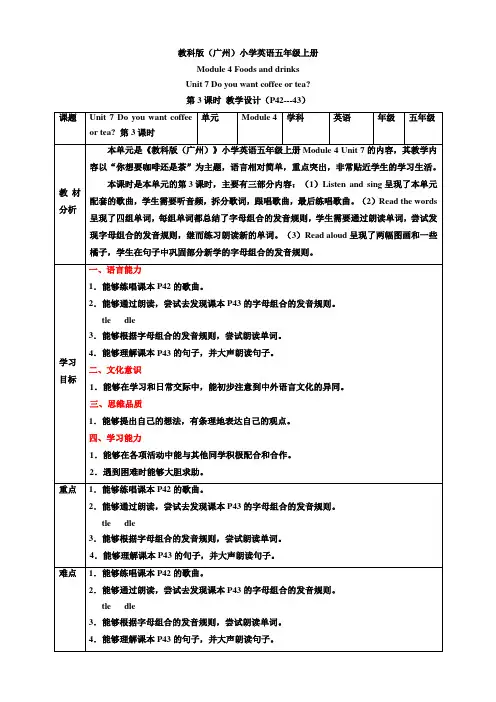
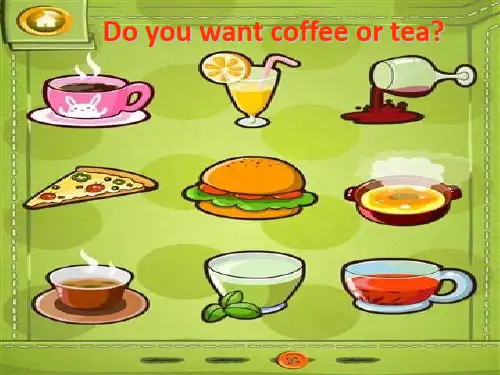
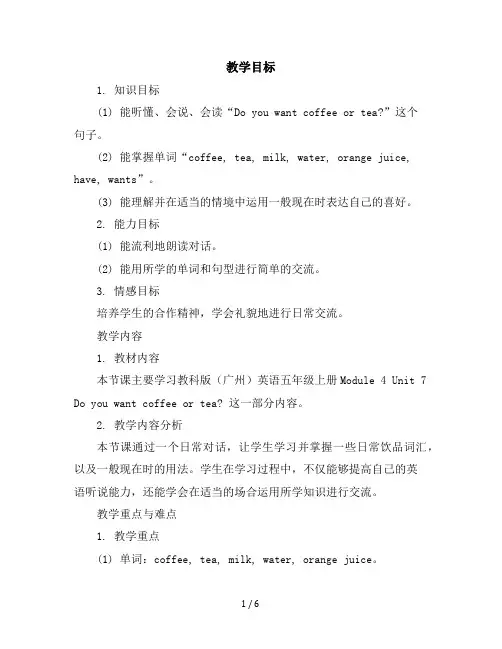
教学目标1. 知识目标(1) 能听懂、会说、会读“Do you want coffee or tea?”这个句子。
(2) 能掌握单词“coffee, tea, milk, water, orange juice, have, wants”。
(3) 能理解并在适当的情境中运用一般现在时表达自己的喜好。
2. 能力目标(1) 能流利地朗读对话。
(2) 能用所学的单词和句型进行简单的交流。
3. 情感目标培养学生的合作精神,学会礼貌地进行日常交流。
教学内容1. 教材内容本节课主要学习教科版(广州)英语五年级上册Module 4 Unit 7 Do you want coffee or tea? 这一部分内容。
2. 教学内容分析本节课通过一个日常对话,让学生学习并掌握一些日常饮品词汇,以及一般现在时的用法。
学生在学习过程中,不仅能够提高自己的英语听说能力,还能学会在适当的场合运用所学知识进行交流。
教学重点与难点1. 教学重点(1) 单词:coffee, tea, milk, water, orange juice。
(2) 句型:Do you want coffee or tea?Yes, I do. / No, I don't.2. 教学难点一般现在时的用法,以及如何在实际情境中运用所学知识。
教具与学具准备1. 教具(1) PPT。
(2) 饮品图片。
(3) 人物角色卡片。
2. 学具(1) 课本。
(2) 练习本。
教学过程1. 导入(1) 利用PPT展示一些饮品图片,引导学生进行复习。
(2) 邀请学生用英语介绍自己喜欢的饮品。
2. 新课呈现(1) 利用PPT展示本节课的主要内容,引导学生学习新单词和句型。
(2) 分角色朗读对话,让学生模仿并跟读。
3. 课堂练习(1) 分组进行角色扮演,让学生在实际情境中运用所学知识。
(2) 完成课本配套练习。
4. 巩固练习(1) 利用PPT设计一些游戏,让学生在游戏中巩固所学知识。
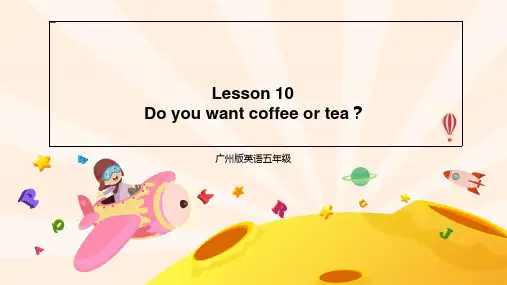

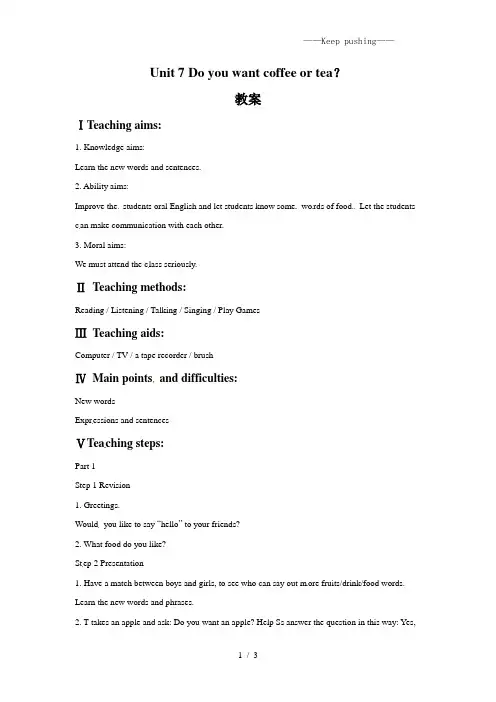
Unit 7 Do you want coffee or tea?教案ⅠTeaching aims:1. Knowledge aims:Learn the new words and sentences.2. Ability aims:Improve the students oral English and let students know some wo rds of food.Let the studentsc an make communication with each other.3. Moral aims:We must attend the class seriously.ⅡTeaching methods:Reading / Listening / Talking / Singing / Play GamesⅢTeaching aids:Computer / TV / a tape recorder / brushⅣMain points and difficulties:New wordsExpr essions and sentencesⅤTeaching steps:Part 1Step 1 Revision1. Greetings.Would you like to say “hello” to your friends?2. What food do you like?St ep 2 Presentation1. Have a match between boys and girls, to see who can say out m ore fruits/drink/food words. Learn the new words and phrases.2. T takes an apple and ask: Do you want an apple? Help Ss answer the question in this way: Yes,please/ No, thank you.Ask Ss practice the dialogue with other things.Step 3 Drills1. Listen to the tap e.2. Read after the tape.3. Read out the words a nd sentences according to the computer.Check up the result.Act the text.Step 4 Exercise1. Remember the w ords.2. Read Part A after class.Part 2Step 1 Revision1. Greetings.Good morning. /Afternoon everyone. / Ho w are you? /Who is on duty today?2. Go over the words and sentences in part A and B.Step 2 Presentation1. Show some cards of food and fruits and ask Ss look and say out the words quickly. Make sentences according to the pictures giving. Can use the sentences learnt last class.2. Learn to say the sentence pattern:---Do you want some salt?---Yes, please. / No, thank you.Step 3 Practice1. Draw and make the cards.2. Play the cards game.3. Read out the words and sente nces according to the computer.4. Check up the result.Step 4 Exercise1. Remember the words.2. Read Part A after class.Part 3Step 1 Greetings and RevisionT: Class begins.S: Stand up. Good morning/afternoon teacher.T: G ood morning/afternoon. Sit down please.S: Thank you!Step 2 P resentation1. L earn Part D: ask Ss the text by themselves, find out the new words and sentences.2. Ask student to explain the meaning of the text.3. Finish the exercises.Step 3 Drills1. Read Part D after the teacher.2. Precise by themse lves.3. Look at the pictures and finish part F.Step 4 Exercises1. Do the exercises book’s Part C and part D2. Try their best to recite A and B.。

教案:Unit 7 Do you want coffee or tea 第2课时一、教学目标1. 知识目标(1)能够听懂、会说、会读本课的生词和句子:“coffee”、“tea”、“milk”、“water”、“orange juice”、“Do you wantor”、“Yes, I do. / No, I don't.”。
(2)能够运用所学知识进行简单的日常交际。
2. 能力目标(1)能够正确使用日常英语进行简单的问候和交流。
(2)能够根据实际情况选择合适的饮品。
3. 情感目标培养学生的合作意识,使他们更加热爱生活,关注健康。
二、教学内容1. 课题:Unit 7 Do you want coffee or tea2. 课题内容:学习有关饮品的选择和日常交际用语。
三、教学重点与难点1. 重点:掌握本课的生词和句子,能够进行简单的日常交际。
2. 难点:正确使用日常英语进行问候和交流。
四、教具与学具准备1. 教具:PPT、录音机、磁带。
2. 学具:课本、练习册、录音机、磁带。
五、教学过程1. 热身(5分钟)(1)教师与学生进行简单的英语问候,营造轻松的课堂氛围。
(2)学生自由交谈,分享彼此的喜好。
2. 导入(10分钟)(1)教师播放上一课时的录音,让学生跟读。
(2)教师出示本课的课题,引导学生预习。
3. 课堂讲解(15分钟)(1)教师讲解新单词和句子,让学生跟读。
(2)教师通过举例和情景模拟,让学生理解并运用所学知识。
4. 课堂练习(10分钟)(1)学生分组进行角色扮演,运用所学知识进行日常交际。
(2)教师选取部分学生进行表演,给予评价和指导。
5. 课堂小结(5分钟)6. 作业布置(5分钟)学生回家后,复习本节课的内容,并完成练习册上的相关练习。
六、板书设计板书课题:Unit 7 Do you want coffee or tea板书内容:coffee tea milk water orange juiceDo you wantor Yes, I do. / No, I don't.七、作业设计1. 抄写本课的生词和句子,每个词和句子写两遍。
教科版五上Unit7Do you want coffee or tea?课后作业巩固【基础训练】一、选出画线部分的发音与其他不同的单词。
( )1. A. bottle B. little C. title D. middle( )2. A. able B. apple C. simple D. purple( )3. A. drink B. milk C. ill D. ice( )4.A. bottle B. coffee C. coke D. hot( )5. A. coke B. cinema C. cup D. cat二、根据图意和所给的首字母,写出句子所缺的单词。
1. 2. 3. 4. 5. 6.1.—What do you want to d___________ for lunch?—I want two g________ of w___________.2. I want three b___________of orange j___________, please.3.(海珠期末) This is a c___________ of t___________.4. I feel hot. I want s___________ c___________.5. The milk and the coke a___________¥2.5 e___________.6. Do you want c___________ or m___________?【提升训练】三、选择最佳答案填空,并把其字母编号写在括号内。
( )1.—What__________ your father want__________ for dinner?—He wants a bottle of orange juice.A. does;to drinkB. does; to eatC. does; drink ( )2. The_________has two__________.A. boys; watchesB. boy; watchC. boy; watches( )3.(天河期末)It’ s cold outside. I want___________to drink.A. something hotB. something coldC. hot something ( )4. Jiamin doesn’t like coke__________ juice. He likes milk.A.andB. butC. or( )5.(越秀期末) There are__________ on the table.A. a cup of teaB. two glasses of milkC. some coffee ( )6. The coffee is 20 yuan, and the milk tea is 15 yuan. That will_________35 yuan, please.A. isB. areC. be( )7. What do you want to drink__________ breakfast?A .of B. to C. for( )8. He wants to have a cup of tea___________milk for lunch.A. withB. of C .to( )9.—DO you want water or juice?—_____________A. Yes,I do.B. Water, please.C. No,I do.( )10. The cake______ 2 yuan. And the juice and milk tea_______ 4 yuan each.A.is;areB. are: areC.is;is四、阅读短文,根据图意和首字母提示,填写短文所缺的单词。